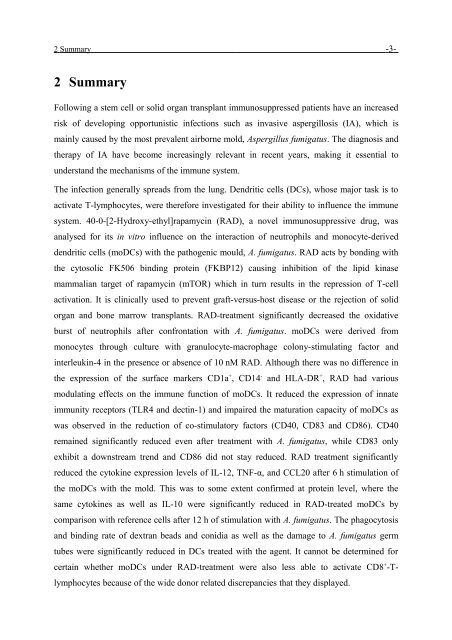Dokument 1.pdf - OPUS - Universität Würzburg
Dokument 1.pdf - OPUS - Universität Würzburg
Dokument 1.pdf - OPUS - Universität Würzburg
Sie wollen auch ein ePaper? Erhöhen Sie die Reichweite Ihrer Titel.
YUMPU macht aus Druck-PDFs automatisch weboptimierte ePaper, die Google liebt.
2 Summary<br />
2 Summary<br />
Following a stem cell or solid organ transplant immunosuppressed patients have an increased<br />
risk of developing opportunistic infections such as invasive aspergillosis (IA), which is<br />
mainly caused by the most prevalent airborne mold, Aspergillus fumigatus. The diagnosis and<br />
therapy of IA have become increasingly relevant in recent years, making it essential to<br />
understand the mechanisms of the immune system.<br />
The infection generally spreads from the lung. Dendritic cells (DCs), whose major task is to<br />
activate T-lymphocytes, were therefore investigated for their ability to influence the immune<br />
system. 40-0-[2-Hydroxy-ethyl]rapamycin (RAD), a novel immunosuppressive drug, was<br />
analysed for its in vitro influence on the interaction of neutrophils and monocyte-derived<br />
dendritic cells (moDCs) with the pathogenic mould, A. fumigatus. RAD acts by bonding with<br />
the cytosolic FK506 binding protein (FKBP12) causing inhibition of the lipid kinase<br />
mammalian target of rapamycin (mTOR) which in turn results in the repression of T-cell<br />
activation. It is clinically used to prevent graft-versus-host disease or the rejection of solid<br />
organ and bone marrow transplants. RAD-treatment significantly decreased the oxidative<br />
burst of neutrophils after confrontation with A. fumigatus. moDCs were derived from<br />
monocytes through culture with granulocyte-macrophage colony-stimulating factor and<br />
interleukin-4 in the presence or absence of 10 nM RAD. Although there was no difference in<br />
the expression of the surface markers CD1a + , CD14 - and HLA-DR + , RAD had various<br />
modulating effects on the immune function of moDCs. It reduced the expression of innate<br />
immunity receptors (TLR4 and dectin-1) and impaired the maturation capacity of moDCs as<br />
was observed in the reduction of co-stimulatory factors (CD40, CD83 and CD86). CD40<br />
remained significantly reduced even after treatment with A. fumigatus, while CD83 only<br />
exhibit a downstream trend and CD86 did not stay reduced. RAD treatment significantly<br />
reduced the cytokine expression levels of IL-12, TNF-α, and CCL20 after 6 h stimulation of<br />
the moDCs with the mold. This was to some extent confirmed at protein level, where the<br />
same cytokines as well as IL-10 were significantly reduced in RAD-treated moDCs by<br />
comparison with reference cells after 12 h of stimulation with A. fumigatus. The phagocytosis<br />
and binding rate of dextran beads and conidia as well as the damage to A. fumigatus germ<br />
tubes were significantly reduced in DCs treated with the agent. It cannot be determined for<br />
certain whether moDCs under RAD-treatment were also less able to activate CD8 + -T-<br />
lymphocytes because of the wide donor related discrepancies that they displayed.<br />
- 3 -

















